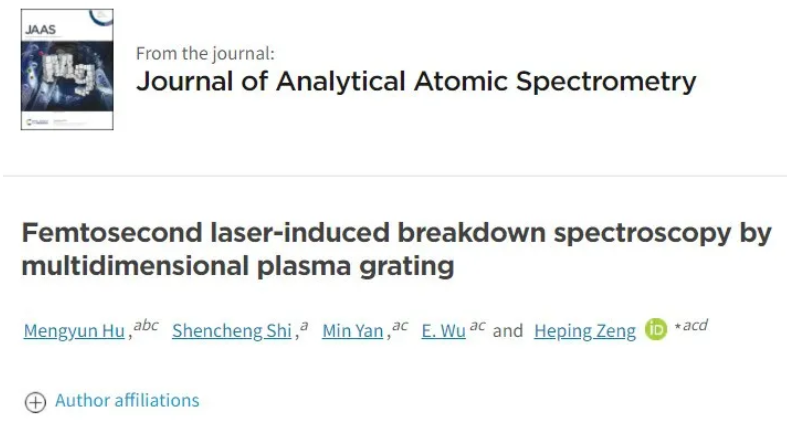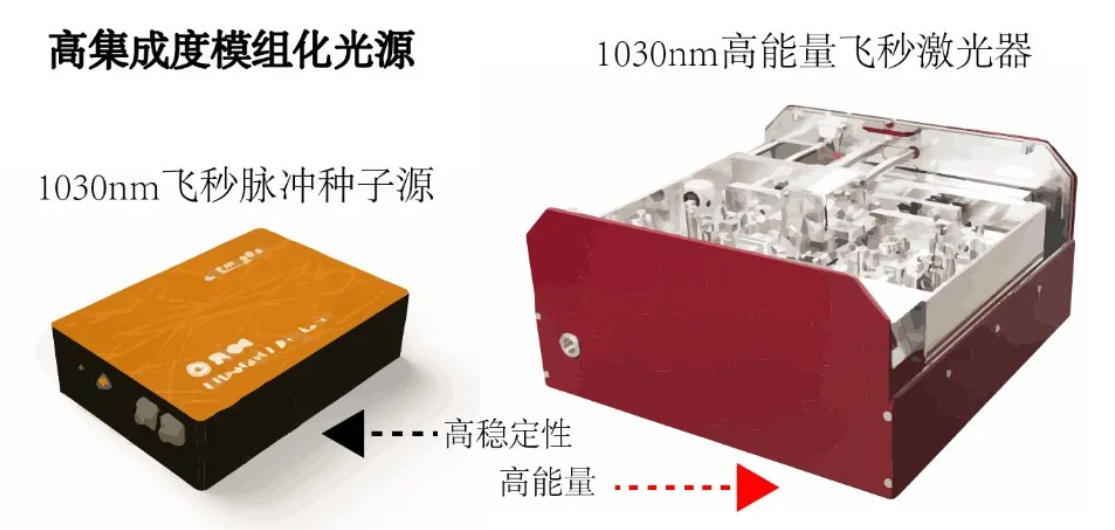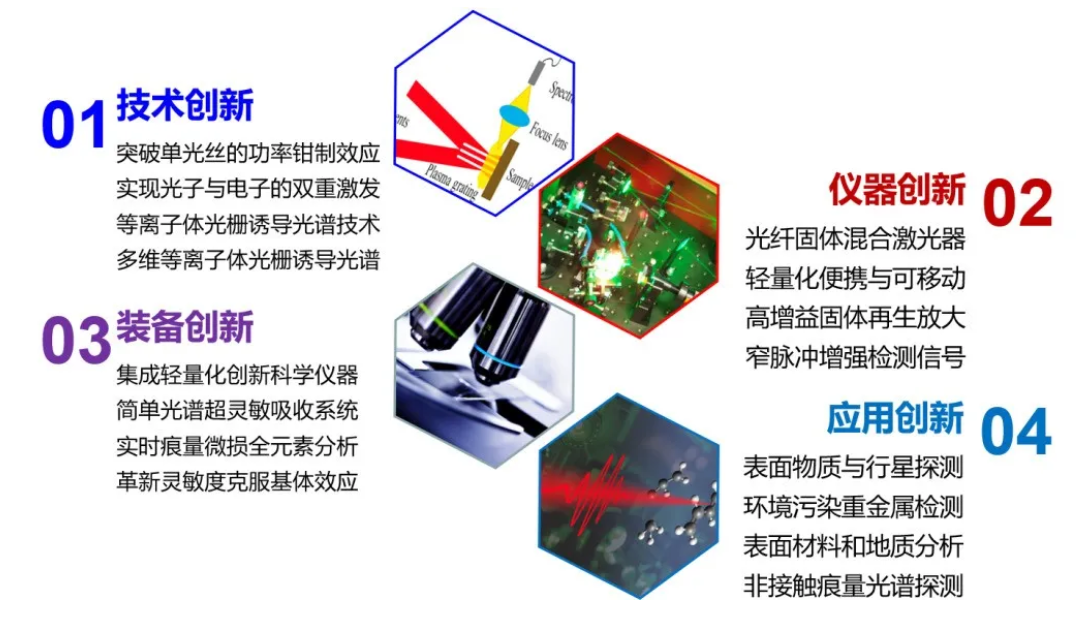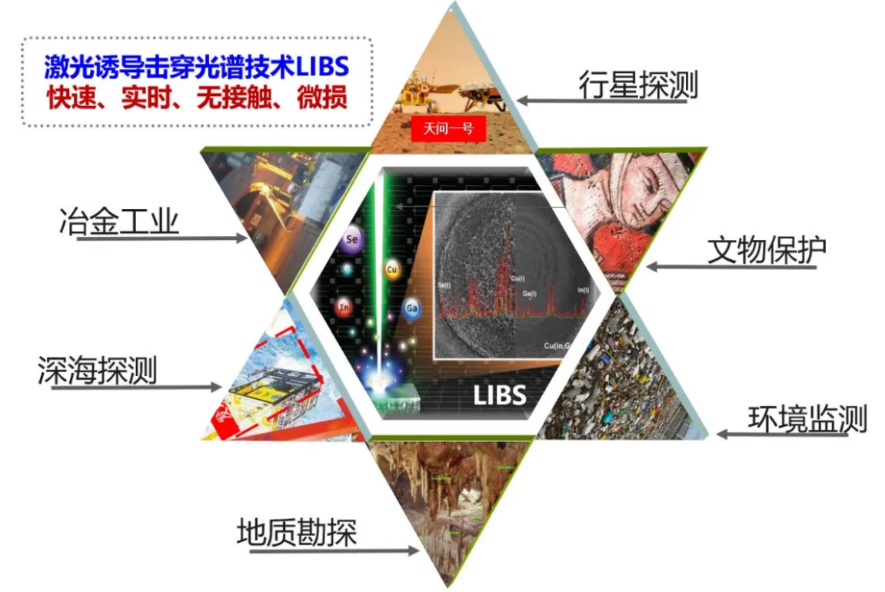Recently, the scientific research team of Chongqing Research Institute of East China Normal University cooperated with the State Key Laboratory of Precision Spectroscopy Science and Technology to make important progress in the research of ultrafast laser induced breakdown spectroscopy. The team first proposed the multi-dimensional plasma grating induced breakdown spectroscopy (MIBS) technology, and verified that the new technology has higher detection sensitivity than conventional laser induced breakdown spectroscopy and overcomes matrix effects. The related achievements were published in the Journal of Analytical Atomic Spectrology, titled Femtosecond laser induced breakdown spectroscopy by multidimensional plasma grating (Hu Mengyun, Shi Shencheng, Yan Ming, Wu Chen, Zeng Heping, JAAS, 2022).

The research results of Professor Zeng Heping's team were published in the Journal of Analytical Atomic Spectrometry
Laser-induced breakdown spectroscopy (LIBS) is a very practical analytical testing tool that can be used to determine the elemental composition of solids, liquids, and gases. Traditional nanosecond laser-induced breakdown spectroscopy is affected by interference from matrix effects and plasma shielding, while Femtosecond Filament-induced breakdown spectroscopy (FIBS) is limited by peak power confinement, making it difficult to improve sensitivity. The team previously developed the femtosecond plasma-grating-induced breakdown spectroscopy (GIBS) technique, forming a plasma grating based on two femtosecond filaments noncollinear coupling, breaking through the peak power clamping effect,increasing optical power and electron density by nearly two orders of magnitude. Multi-photon ionization and electron collision excitation in the plasma grating cooperate to improve detection sensitivity (Hu Mengyun, Peng Junsong, Niu Sheng. Zeng Heping, Advanced Photonics, 2020, 2(6), 065001); GIBS plasma interference excitation can overcome the matrix effect, achieving self calibration for component detection.
In order to further improve the excitation effect on the sample, extend the lifetime of the plasma generated by excitation, and enhance the spectral signal, the team proposed a new technology of multi-pulse coupling excitation-induced breakdown spectroscopy (MIBS) based on plasma grating. The team used three non-collinear and non-coplanar femtosecond pulses to interact with each other tc excite the sample, successfully observing the diffraction effect of plasma grating. which achieved a breakthrough from one-dimensional to two-dimensional. When two-dimensional plasma grating is used to excite the sample, there are more fine periodic structures and higher-order nonlinear effects in the two-dimensional plasma channel, which enhance the plasma density and optical power density, and multi-photon excitation and electronic collision dual excitation are more obvious, thus further improving the detection sensitivity and overcoming the matrix effect.

MIBS experimental device, the periodic structure of two-dimensional plasma grating makes the third harmonic diffract.
Itis worth mentioning that the spectral line signal obtained by the research study will increase with the increase of laser energy. When the single pulse energy exceeds 2mJ. At this time, MIBS technology will gain more obvious advantages. In addition, MIBS technology has only been improved on the excitation source, withoutintroducing complex sample processing steps and additional devices, retaining the original advantages of LIBS technology such as rapid, simple, and convenient detection, which makes it capable of meeting the in situ real-time detection requirements in specific scenarios.
With the development and application expansion of GIBS/MIBS technology, in order to adapt to mobile operations in harsh outdoor environments and achieve non-contact online real-time detection, higher requirements have been placed on the excitation light source, requiring a high-energy femtosecond light source with more stable performance for excitation. At the same time, East China Normal University Chongqing Research Institute has developed a high-energy femtosecond pulse laser light source. Based on the femtosecond laser amplification scheme combining Yb-doped fiber seed pulse generation and solid-state regeneration amplification, by building a broadband tunable fiber pulse seed source to solve the problems of signal light and amplification medium spectral narrowing and gain mismatch, high-efficiency laser amplification is realized. Combined with chirped pulse amplification and solid-state regeneration amplification technology, nonlinear accumulation during laser amplification is suppressed, amplification efficiency and power are improved, and mJ level high-energy femtosecond pulse laser is output. The highly integrated and stable hybrid system with a 1030nm mJ level high-energy femtosecond laser source meets the requirements of harsh environments outside the laboratory, providing technical and instrumental support for online detection in the field of GIBS/MIBS technology experiments.

1030nm high-energy femtosecond laser
In addition, the Chongqing Research Institute of East China Normal University has developed multiple series of ultrafast femtosecond laser sources, forming multiple ultrafast femtosecond laser products, including FemtoCK, FemtoLine, and FemtoStream. A 1030nm mJ level high-energy femtosecond laser YbFemto HP is developed for applications such as GIBS/MIBS technology, strong field laser physics, and micro/nano processing. The YbFemto HP adopts a fiber solid hybrid amplification technology scheme, and the seed source uses a fully polarization maintaining fiber oscillator Femto CK to generate a stable pulse sequence; This light source uses chirped pulse amplification technology combined with solid-state regenerative amplification technology of ytterbium doped gain medium to output high-energy femtosecond laser pulses with a central wavelength of 1030nm, energy reaching the millijoule (mJ) level, and a pulse width less than 300fs. The repetition frequency tuning range of this light source covers a single pulse to 250 kHz, and a customized module can be added for frequency doubling operation, achieving femtosecond pulse laser output of 515nm, 343nm, etc., meeting the needs of multiple scenarios such as scientific research and industry.

The Chongqing Research Institute of East China Normal University will rely on its self-developed millifocal level high-energy femtosecond laser to output a highly stable excitation light source, combined with GIBS/MIBS technology, to integrate lightweight and highly sensitive detection instruments, achieve technological innovation, instrument innovation, equipment innovation, and further achieve application innovation in soil and liquid self calibration trace analysis. The stability and reliability of the instrument system will be deeply optimized, making more applications in extreme outdoor environments possible, and further applied in fields such as environmental monitoring, deep-sea exploration, geological exploration, industrial metallurgy, aerospace exploration, and biopharmaceuticals.

Application of laser-induced breakdown spectroscopy technology
The millifocal level high-energy femtosecond laser not only has important applications in LIBS, but also can be used for device integration, targeting important applications such as semiconductor chip preparation, flexible OLED display device cutting, glass cutting, non-metal/metal material processing, drilling, and micro/nano processing. On the other hand, it can be used for scientific research applications such as spectral detection, nonlinear optics, high-order harmonic generation, medical imaging, two-photon 3D printing, phased array, etc.
Source:华东师范大学重庆研究院科研团队在激光诱导击穿光谱研究中取得进展
Link to the paper:https://pubs.rsc.org/en/content/articlelanding/2022/ja/d1ja00376c
